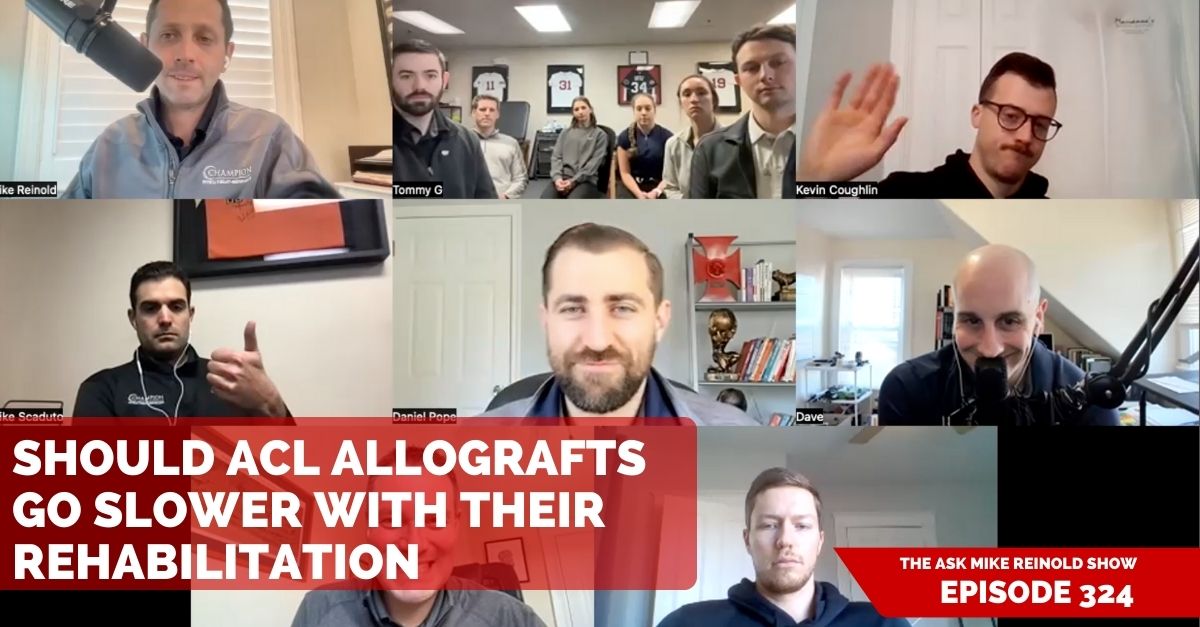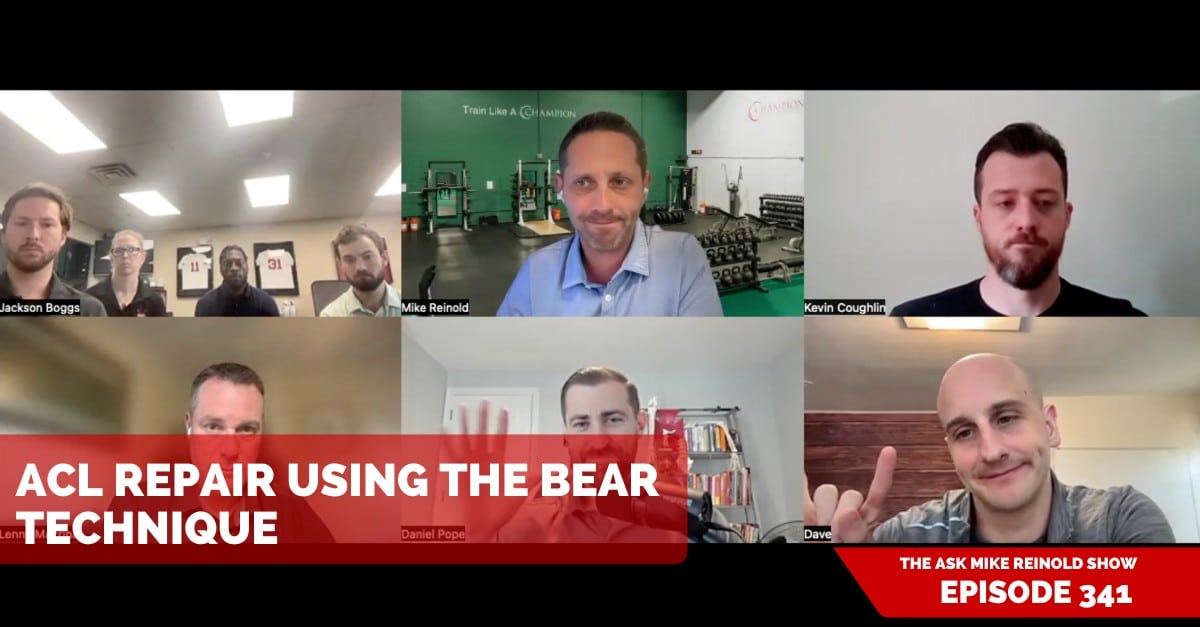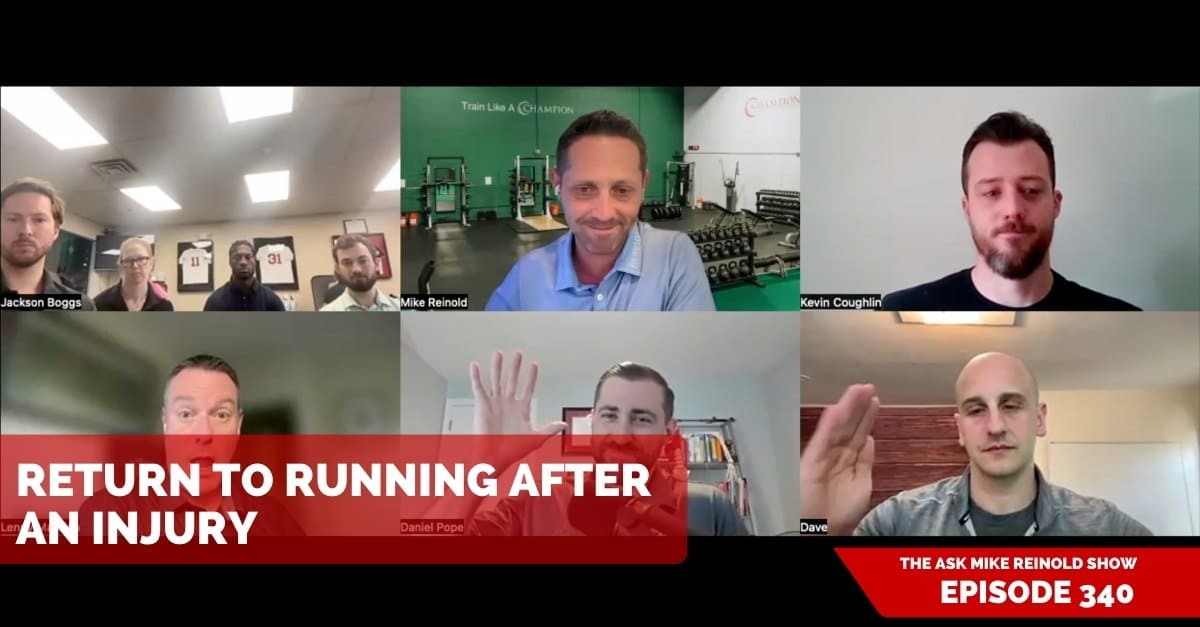There are many options for graft sources when performing an ACL reconstruction. There are pros and cons to them all.
One graft type, an allograft, probably deserves a different rehabilitation approach. We often go slower with this graft type.
We talk about why in this episode.
To view more episodes, subscribe, and ask your questions, go to mikereinold.com/askmikereinold.
#AskMikeReinold Episode 324: Should ACL Allografts Go Slower with Their Rehabilitation
Listen and Subscribe to Podcast
You can use the player below to listen to the podcast or subscribe. If you are enjoying the podcast, PLEASE click here to leave us a review in iTunes, it will really mean a lot to us. THANKS!
Show Notes
• ACL Graft Options with Lenny Macrina
• What is the Best Graft Choice for ACL Reconstruction?
Transcript
Colin:
Elliot from El Paso, Texas asks, “Does rehab following an allograft ACL reconstruction necessitate more gentle rehab as it is documented that allografts take longer to heal and are also significantly more prone to failure, especially in younger, more active populations. Does this rehab type depend on the age and goals, athlete versus non-athlete, of the individual?
Mike Reinold:
Awesome. Great job, Colin. Roll tide. Great job with that question. I don’t know, Elliot, you ask a common question, right, that we’ve answered over the years a little bit here and there, but I think it’s always best to revisit these as we go along. But I don’t know, ACL allografts in general, you use the word gentle. I don’t know if gentle is the right word. When I read the question, I was like, I want to hear what Lenny says with that. It’s not necessarily gentle. Is it more just cautious or slow? I don’t know. Len, I feel like…
Lenny Macrina:
Yeah.
Mike Reinold:
You’re just going to want to talk on this one, so why don’t you start it off and if anybody’s got anything, we can go from there.
Lenny Macrina:
I think gentle is very appropriate. No, yeah, I mean I think it’s relatively gentle, so to speak, compared to the autograft reconstructions that we do. Meaning we want somebody to start running in four or five months. In my head, an allograft should be delayed one or two months for some of the big milestones. So with range of passive motion, no, we can get them moving, getting knee extension, get that, get the quads back.
But I think when it comes down to the higher level stuff, the plyometrics, the jogging, the cutting, the return to sport considerations, the timeframes of getting them back to their sport, I think that’s where things become delayed and slower because of the incorporation of the graft. I mean, you have not your own tissue being put into your knee as you guys know. And it depends on the status of the tissue too. Is it irradiated or non-irradiated tissue? I think there are so many different variables, how the graft was incorporated, the tunnel placements, and stuff that we may not even know as a PT when we’re getting that person post-surgical.
We just know it’s an allograft. Is it a patella tendon or a tibialis anterior graft? Is it an Achilles? So many different variables, fixation of the graft to the bone, that interface, so many different things can influence healing times, but we know it takes longer for the graft to incorporate into ligament ties. And so I think that has to be a consideration when we’re getting these people back is it just takes longer. So it should take longer to get them back.
Unfortunately, well, fortunately for the patient, their quads come back faster in general, and so they feel better. There’s less pain, and so there’s this propensity to try to get them back faster. I think that’s where we… That’s our disservice. But I think the early stuff, get their motion back, get their swelling out, stuff that we typically do, I think it’s still safe to do at the relatively same pace as an autograft.
Mike Reinold:
I love it. And I like the point that you made here too, that it’s almost like resist the urge that just because they feel so much better and their quad’s coming back, maybe the knee seems settled down, resist the urge. This is a different type of tissue healing. So I think that’s a really good point.
Lenny Macrina:
Still a biological process has to occur. Yeah.
Mike Reinold:
Yeah. So does anybody think the early phase rehab in terms of range of motion, swelling, control, getting your quad turned on, starting to do some neuromuscular stuff, is that delayed with an allograft, or are we more talking about the return to more dynamic activities? One at a time.
Dan Pope:
I say something, I think it’s your point, right? What does gentle mean? If we know we’re using, let’s say a closed chain exercise, we’re not putting a ton of stress on that graft, right? And the other part is we still need to make sure that they’re building up their strength and we know that it’s really, really challenging to build back quad strength. Like Lenny said, maybe comes back a little faster, but at least in my mind, I don’t think we have to be careful with let’s say safe exercises.
But the big milestones, if I’m going to be running, jumping, changing direction, and putting a lot of strain on that ACL, we know some of those numbers are much, much higher than let’s say a closed chain exercise in the early stages. And maybe we have to be a little bit cautious with some of the open chain stuff. I know that there’s some recent research at the four week mark with open connect chain, but that’s not with the cadaver. Maybe we have to be a little more cautious with those. But for the safer closed chain, I see no reason not to treat that similarly, right? We can still kind of push folks from that perspective. So I would say the early stages are probably similar, but when you get to the higher level exercises we know are more challenging to the graph, then we probably do have to be a little more cautious.
Mike Reinold:
I like that. That’s awesome, Dan. And I like what you did there in terms of there’s some things that we don’t have to be gentle with, and I think that’s where we go back down to Elliot’s question with gentle. There are some things we don’t need to be gentle with, but there are other things we could just be more strategic with, maybe. And I think you just said that really well. We can still strengthen, but maybe we’re picking and choosing our strengthening differently.
So that’s a good question I have for everybody. So if somebody has an allograft, would you change your open kinetic chain knee extension progression in terms of range of motion and load? What do you think? Because it’s a big topic right now on social media.
Lenny Macrina:
I would go slower just because allografts, I mean, I got to be careful. Allografts are just more of a challenge for the knee, for the person in general for healing, for outcomes. And I don’t want to be the reason why. Now I know if you don’t get the quads back, that’s a huge reason why a knee is going to fail. And I’d say fail, meaning re-rupture, long-term OA due to weakness. I just think for the stress that we could potentially put on it is just – I don’t want to be the reason why something fails.
And if I have to delay open chain stuff by two to four weeks or something like that, that’s fine in my head. I can work on it in other ways. And I think that’s just going to be a little safer bet because I know the issues with incorporating a cadaver graft, you can struggle at times and sometimes we don’t even know the biology is failing and it is failing inside. And you got to be careful with that too. We don’t know that until it does actually fail.
Mike Reinold:
So you’d delay it a little bit. Would you delay full range of motion knee extension, or do you more delay the load of it, or is it both?
Lenny Macrina:
Probably a little of both early on, I think so, yeah. And maybe that’s my old-school thinking. I think it does warrant a delay versus an autograft. It’s your own tissue.
Mike Reinold:
And we could still get strong in other ways, like Dan mentioned earlier, and we can get to loading later.
Lenny Macrina:
Yeah.
Mike Reinold:
Awesome. What else? Dan, did you have something else?
Dan Pope:
Yeah, I was just going to say about your earlier point. One of the problems is that these folks tend to feel better, right? I know one of the surgeons we work with a lot, when he does a cadaver graft, he wants people partial weight bearing for a period of time just because he’s probably fearful of the graft, right? And I think one of the issues is that one of our criteria, and obviously there are many for progressing patients, is making sure it’s not super painful when you’re doing exercises. And I think one of the problems or issues with cadavers is they feel quite a bit better. So they might be more apt to push harder in the early stages where other folks might be held back a bit more by pain. I think that’s just got to be a consideration because you’re going to have a patient that feels pretty dang good, and the problem is that they might have to be held back a little more so, especially in those early stages.
Lenny Macrina:
And I think we have to set the tone early. I hate to drop these bombs on patients when they have expectations, they start reading stuff on Google or whatever, or they talk to their friends who’ve had an allograft to an autograft. I think you have to set the tone early with your patients of what your expectations are in the rehab and the timeframes and some of the goals that you have to set for them. I think it just helps the process. It helps the buy-in by the patient for you. So they don’t have the expectation that they’re going to start jogging at three months because their friend did. Well, their friend may have had an autograft or their friend is 20 years younger or their friend didn’t have meniscus involvement or something.
There are all these details that are just not, they’re avoided, but I think you have to set the tone early in the rehab, and this is what we’re going to do and kind of outline things in a general way so people are ready for that and they’re not surprised negatively and disappointed in that. Maybe they want to go find somebody else who’s going to be more aggressive with their rehab. I don’t know. You got to sell it to them.
Mike Reinold:
Or less gentle, per Elliot. I like that.
Lenny Macrina:
Yeah, less gentle. Exactly right.
Mike Reinold:
Awesome. So Elliot, I hope that helps. I think if you look at the answer to this question, and this is why I really like the way you phrased this there a little bit with allografts, sure. Do we get to our functional stuff later down the road that has high load? Do we do that later than in autograft? Yes, absolutely. Because we want to make sure that works well. We want to make sure that that quad’s probably stronger when they start things like running, jogging, cutting, getting back to sports, that sort of stuff.
But I think the main point, hopefully, we get from this conversation here is that it’s not necessarily that you need to go gentle at the beginning, but you have to be intelligent and strategic with how you change things perhaps. And I think that’s a better way to frame it in your mind perhaps, is not necessarily that you have to be cautious or slow, you just have to be strategic with how you’re doing it early on.
So great stuff. Appreciate it. Those were some great answers, Lenny. Dan, that was awesome. Elliot, hope that helps. If you have a question like Elliot, please head to mikereinold.com, click on that podcast link, and ask away and we’ll be sure to answer your question on a future episode. Thanks so much.





